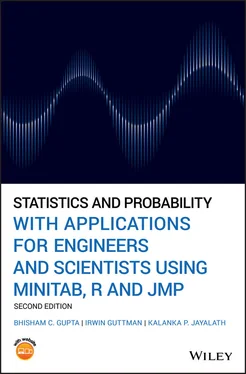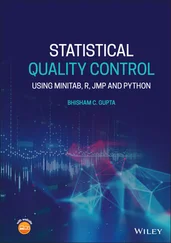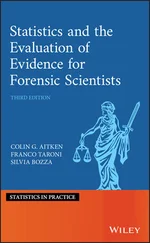Carefully examining the stem‐and‐leaf plot in Figure 2.4.13, we note that the data are clustered together; each stem has many leaves. This situation is the same as when we have too few classes in a frequency distribution table. Thus having too many leaves on the stems makes the stem‐and‐leaf diagram less informative. This problem can be resolved by splitting each stem into two, five, or more stems depending on the size of the data. Figure 2.4.14shows a stem‐and‐leaf plot when we split each stem into two stems.
The first column in the above stem‐and‐leaf plots counts from the top, and at the bottom is the number of workers who have produced up to and beyond certain number of parts. For example, in Figure 2.4.14, the entry in the third row from the top indicates that 35 workers produced fewer than 75 parts/wk, whereas the entry in the third row from the bottom indicates that 37 workers produced at least 80 parts/wk. The number within parentheses gives the number of observations on that stem and indicates that the middle value or the median of the data falls on that stem. Furthermore, the stem‐and‐leaf plots in Figure 2.4.14is more informative than Figure 2.4.13. For example, the stem‐and‐leaf plot in Figure 2.4.14clearly indicates that the data is bimodal, whereas Figure 2.4.13fails to provide this information. By rotating the stem‐and‐leaf plot counterclockwise through 90°, we see that the plot can serve the same purpose as a histogram, with stems as classes or bins, leaves as class frequencies, and columns of leaves as rectangles or bars. Unlike the frequency distribution table and histogram, the stem‐and‐leaf plot can be used to answer questions such as, “What percentage of workers produced between 75 and 83 parts (inclusive)?” Using the stem‐and‐leaf plot, we readily see that 20 of 80, or 25% of the workers, produced between 75 and 83 parts (inclusive). However, using the frequency distribution table, this question cannot be answered, since the interval 80–85 cannot be broken down to get the number of workers producing between 80 and 83 per week. It is clear that we can easily retrieve the original data from the stem‐and‐leaf plot.
1 Enter the data in column C1.
2 From the Menu bar, select Graph Stem‐and‐leaf. This prompts the following dialog box to appear on the screen. In this dialog box,
3 Enter C1 in the box under Graph variables.
4 Enter the desired increment in the box next to Increment. For example, in Figures 2.4.13and 2.4.14, we used increments of 10 and 5, respectively.
5 Click OK. The stem‐and‐leaf plot will appear in the Session window.
USING R
We can use the built in ‘stem()’ function in R to generate stem‐and‐leaf plots. The extra argument ‘scale’ can be used to define the length of the stem. The task can be completed by running the following R code in R Console window.
SpareParts = c(73,70,68,79,84,85,77,75,61,69,74,80,83,82,86,87,78,81, 68,71,74,73,69,68,87,85,86,87,89, 90,92,71,93,67,66,65,68,73,72,83, 76,74,89,86,91,92,65,64,62,67,63,69,73,69,71,76,77,84,83,85,81,87, 93,92,81,80,70,63,65,62,69,74,76,83,85,91,89,90,85,82) #To plot stem‐and‐leaf plot stem(SpareParts, scale = 1) #R output
| The decimal point is 1 digit(s) to the right of the | |
| 6 |
| |
122334 |
| 6 |
| |
555677888899999 |
| 7 |
| |
00111233334444 |
| 7 |
| |
56667789 |
| 8 |
| |
0011122333344 |
| 8 |
| |
555556667777999 |
| 9 |
| |
001122233 |
PRACTICE PROBLEMS FOR SECTION 2.4
1 Prepare a pie chart and bar chart for the data in Problem 2 of Section 2.3.
2 Prepare a pie chart and bar chart for the data in Problem 3 of Section 2.3and comment on the cars the senior citizens like to drive.
3 Prepare a line graph for the data in Problem 5 of Section 2.3and state whether these data show any patterns. Read the data columnwise.
4 Use the data in Problem 6 of Section 2.3to do the following:Construct a frequency histogram for these data.Construct a relative frequency histogram for these data.Construct a frequency polygon for these data.Construct an ogive curve for these data.
5 Construct two stem‐and‐leaf diagrams for the data in Problem 4 of Section 2.3, using increments of 10 and 5, and comment on which diagram is more informative.
6 Construct a stem‐and‐leaf diagram for the data in Problem 6 of Section 2.3. Then, reconstruct the stem‐and‐leaf diagram you just made by dividing each stem into two stems and comment on which diagram is more informative.
7 A manufacturing company is very training oriented. Every month the company sends some of its engineers for six‐sigma training. The following data give the number of engineers who were sent for six‐sigma training during the past 30 months:182016301416222416141619182423281812181517212225272319182026Using technology, prepare a complete frequency distribution table for these data.
8 A manufacturer of men's shirts is interested in finding the percentage of cotton in fabric used for shirts that are in greater demand. In order to achieve her goal, she took a random sample of 30 men who bought shirts from a targeted market. The following data shows the cotton content of shirts bought by these men (some men bought more than one shirt, so that here ):35256535503540506555255565352535455565553545354520354045356535503530356535253520356535303565353025356535653520352535303565356535303530653530352035653555353035653565353035653535Prepare a single‐valued frequency distribution table for these data.Prepare a pie chart for these data and comment on the cotton contents in these shirts.
9 The following data give the number of patients treated per day during the month of August at an outpatient clinic in a small California town:20302535324640384441373540414338373532402326272921232833392029Prepare a complete frequency distribution table for the data using six classes.On how many days during August were 36 or more patients treated in the clinic?
10 The following data give the number of parts that do not meet certain specifications in 50 consecutive batches manufactured in a given plant of a company:1619222527183630202429403031343621252428263024161921302420222432271824201733352932363928261718252729Construct a frequency histogram and a frequency polygon for these data.
11 A manufacturer of a part is interested in finding the life span of the part. A random sample of 30 parts gave the following life spans (in months):232530323642282421434648393034352421165425343723242826192737Construct a relative frequency histogram and a cumulative frequency histogram for these data. Comment on the life span of the part in question.
12 The following data give the number of accidents per week in a manufacturing plant during a period of 25 weeks:0412342103402132420535014Construct a single‐valued frequency distribution table for these data.Construct a frequency histogram for these data.During how many weeks was the number of accidents less than 2?During how many weeks was the number of accidents at least 3?What is the relative frequency of 0 accidents?
13 Compressive strengths were measured on 60 samples of a new metal that a car manufacturing company is considering for use in bumpers with better shock‐absorbent properties. The data are shown below:59.758.359.061.558.763.868.265.663.562.459.463.264.560.060.561.568.566.661.358.559.261.360.460.662.163.564.467.367.964.265.469.367.364.562.371.760.760.266.768.564.265.167.059.561.763.167.568.569.261.562.368.466.565.769.362.568.060.562.360.5Prepare a complete frequency distribution table.Construct a frequency histogram.Construct a relative frequency histogram.Construct a frequency and relative frequency polygon.Construct a cumulative frequency histogram and then draw the ogive curve for these data.
Читать дальше












